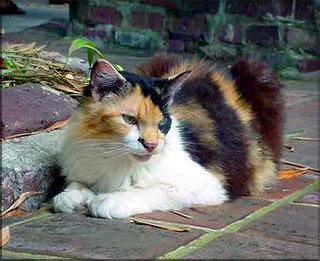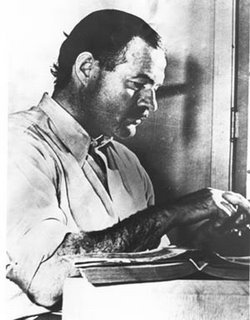The USDA Fines the Hemingway Memorial in Key West $200 a Day for Exhibiting Papa's Polydactyl Cats Without a License

"They're comparing the Hemingway house to a circus or a zoo because there are cats on the premises. This is not a circus. These cats have been here forever."
-- Cara Higgins
Are cats that merely reside on the grounds of a public memorial the same as circus and zoo animals and thus subject to the licensing requirements of the Animal Welfare Act (AWA)?
That is the legal question that a United States District Court in Miami has been called upon to decide in a case involving Ernest Hemingway's famous polydactyl cats in Key West, Florida.
The United States Department of Agriculture's (USDA) Animal and Plant Health Inspection Service has declared that the cats who roam the grounds of the Hemingway Home and Museum are indeed being exhibited and has begun fining the museum $200 a day for its lack of an exhibition license. The trustees of the home have accordingly filed a lawsuit against the USDA.
"They're comparing the Hemingway house to a circus or a zoo because there are cats on the premises," Cara Higgins, an attorney representing the trustees, told Edinburgh's The Scotsman on July 31st. (See "Cat Fight at House of Hemingway.") "This is not a circus. These cats have been here forever."

While museum officials insist that the hundreds of thousands of tourists who visit each year come to see the house where Hemingway wrote such classics as For Whom the Bell Tolls and To Have and Have Not during his decennial stay in America's most southern city in the 1930s and not the cats, the USDA disagrees. "We're asking the judge to let us know whether this act applies to the cats, and if so why that is if the animals are not in commerce," Higgins added.
Currently there are forty-six cats living on the premises; about half of them are polydactyls and nearly all of them are named after celebrities. They are fed and watered daily and receive regular veterinary care. Unfortunately, only the polydactyls are allowed to reproduce.
"They're unique. Each one has its own character, and they're fiercely independent," museum guide Steve Troger told The Scotsman in the article cited supra.
At the top of the page little Patches is shown pussyfooting between Papa's machine a ecrire and a copy of The Old Man and the Sea. The beautiful Ava Gardner is shown directly above resting on a walkway while Archibald MacLeisch is shown below on the left refreshing himself at a drinking fountain made especially for cats. The top part consists of an old Spanish olive jar that came from Cuba while the bottom portion once served as a urinal at nearby Sloppy Joe's Bar.

The story of Papa Hemingway and his cats began in 1935 when sea captain Stanley Dexter gave a female polydactyl named Snowball to Hemingway's sons, Pat and Greg, in return for some errands that they had performed for him. Because of their extra toes, the cats were considered to be lucky and on top of that they were also proficient mousers. The polydactyls who today call the memorial home are direct descendants of her.
Although it is not known how much an exhibition license would cost the home, at the rate of $200 per day for not having one it is going to cost the attraction $73,000 a year if the USDA wins in court. Also troubling is Higgins' callous statement to The Scotsman about wanting to comply with the law. "If it has something to do with the number of cats, how many do we have to get rid of to be in compliance?"
Contrary to Higgins' warped thinking, cats are not something to be gotten rid of, especially Papa Hemingway's cats. Since they have been living at the museum for so long they are entitled to go on living there. Any efforts intended to either harm or remove them should be strenuously opposed by all cat activists.
Charged with overseeing the safety of the nation's food supply, monitoring the spread of Mad Cow Disease, the regulation of genetically modified crops, the safety of laboratory animals, and numerous other vital functions, it is curious that the USDA would have either the time or money to go after Hemingway's cats. Besides, the USDA's precipitate action opens up a Pandora's Box of legal difficulties. For instance, would libraries and amateur sports teams be required to obtain exhibition licenses in order to keep cats?
More than likely the USDA is either after a quick buck or simply going out of its way in order to be obnoxious. After all, when has it ever displayed any genuine concern for farm animals, lab animals, or animals shanghaied into slaving for circuses and zoos? As far as lab animals are concerned, the AWA governs only such peripheral issues as food, water, and cage size; it is totally silent on animal cruelty, mutilation, and murder. Much the same thing can be said for the USDA's feckless oversight of farm animals and those used in entertainment and sports.

Moreover, the agency's stewardship of surplus commodities is so lax that it borders on criminal neglect. For example, in 2003-2004 the USDA turned a blind eye as ranchers resold tens of millions of pounds of powdered milk to feed dealers and brokers who in turn made a packet by exporting the milk abroad. Because of a severe drought out west, the milk had been given to the ranchers gratis by the USDA to feed their allegedly starving herds.
All totaled, the ranchers, feed dealers, and brokers made untold millions off of an emergency milk program that cost taxpayers $400 million. (See Washington Post, July 19, 2006, "Aid to Ranchers Was Diverted For Big Profits.") The message from the USDA is clear: ranchers, farmers, and their middlemen have a license to steal from the government but Hemingway's cats must ante up if they want to go on breathing. This case is so typical of the corruption and repression that is present at every level of government in America today.
Although he has been dead for forty-five years, Hemingway (See photo above on the left) is still widely read today and other establishments in Key West associated with him are also popular with tourists. For instance, Hemingway Days, held this past July 18-23, featured a Hemingway lookalike contest at Sloppy Joe's Bar which was won by fifty-five-year-old Texas Chris Storm. Other events included a marlin tournament, author readings, a short story competition, and an offbeat running of the bulls. His Havana home, Finca Vigia, has been preserved by Comrade Fidel and also attracts many visitors each year.
The polydactyls in Key West are one of the few remaining links between the man and his work. When a visitor gazes into their eyes he or she is seeing an updated version of what Hemingway saw when he stroked their fur all those years ago as he was creating his literary masterpieces.
Hemingway was not only a great writer but a devout cat-lover. Writers and cats go together like ice cream and fresh strawberries. As Desmond Morris once said, "Artists like cats, soldiers like dogs."
It accordingly would be a tragedy of monumental proportions if anything were ever to happen to Papa Hemingway's cats. If worse should come to worse, the Hemingway Home should either purchase an exhibition license or just pay the USDA its $73,000 each year. The cats are worth that much and a lot more. Under no circumstances should any of them be gotten rid of as Higgins has suggested.

Glimpses of the famous felines gamboling on the grounds of the museum (See photo above) can sometimes be seen via webcams at www.hemingwayhome.com.
Photos: Roberto Rodriguez of the Associated Press (Patches), Hemingway Home and Museum (Ava Gardner and Archibald MacLeisch), Wikipedia (Hemingway), and www.myfloridatrips.com (Hemingway's residence).

<< Home